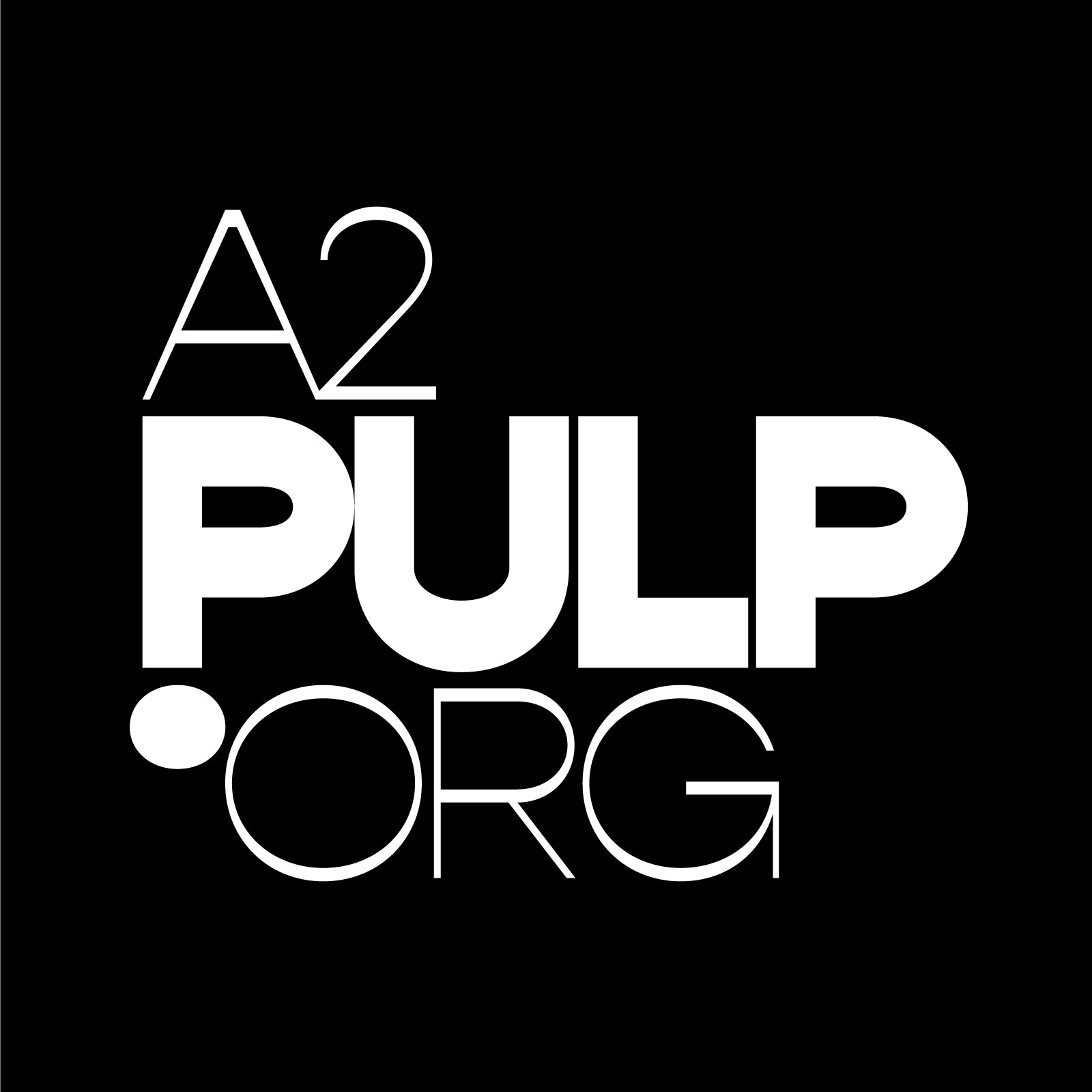Preview: Jenny Pope & the Ann Arbor Art Fair
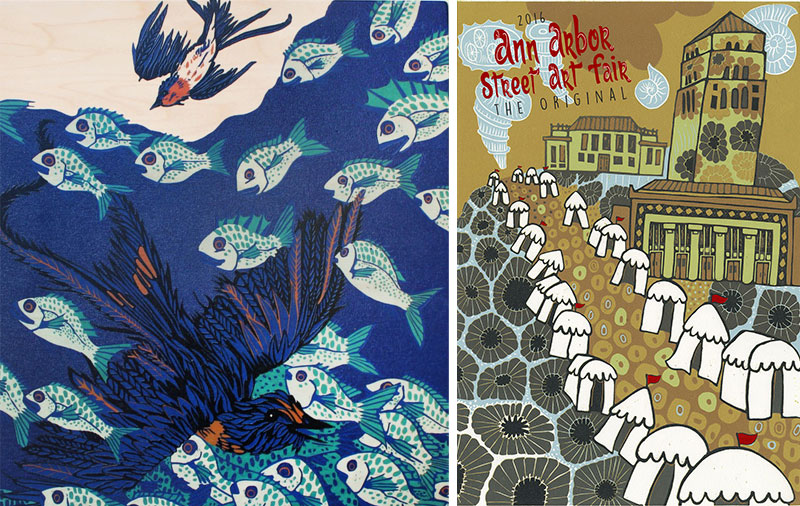
Summer in Ann Arbor often serves as a reminder of Michigan’s natural beauty. Flowers are in full bloom, animals run through our yards, and (even for the heat-phobic) the sunshine is a welcome relief from the dreary winter behind us. For some, like artist Jenny Pope, this draw to nature is year round. Jenny lives in Ithaca, NY and works full-time on her craft while traveling around the country to sell and display her work. Luckily, she will be setting up shop as this year’s featured artist at the Ann Arbor Street Art Fair, one of the four fairs which will be taking over downtown Ann Arbor from July 21st to the 24th.
Primarily a woodcut artist, Jenny is drawn to capturing a variety of flora and fauna from commonplace cardinals to lesser known (but highly invasive) species like lionfish. She reads about, discusses and watches nature endlessly, bringing her acute observational skills and fantastical imagination with her each time she starts a piece. Her unique vision really comes through in all of her work – especially with Jenny’s magical palette of color. After speaking with Jenny, it was clear to me she constantly meditates on her craft while noting the intricacies of the world around her. She brings these observations into her studio, and the results of such a well-lived artist’s life are clear in the quality of her work.
Q: Your range of products is truly impressive. From woodcuts to ceramics, it seems like you have your hand in everything. What was the first medium you worked in, and do you have a favorite medium?
A: I have been making woodcuts for over 10 years and selling them full time for the past 8. Ceramics are a new medium to me, I have been playing with clay for 2 years. I started working with clay just before getting pregnant and it was super helpful to have a second medium. I got so big that I couldn't reach over the etching press to print, so clay was the only medium I could work with. These days I probably spend 80% of my time making woodcuts and 20% of my time working with clay.
Q: The imprints and designs you use recall a very organic and natural element. Beyond the depictions of wildlife and flora, your art seeks to teach the viewer about the environment. For instance, one of my favorite pieces, "Swallows Overwintering Underwater," is part of a series addressing myths of bird migration. What inspired this series and others like it? What role do you view art as having in being a pathway to learning?
A: I enjoy working in series. I read a lot about nature and animals which is where many of my ideas come from. Only recently I have started making a few pieces about my personal history with nature. "Seven Species" is a large woodpecker woodcut about all the species I have seen in my yard and "Resident Cardinals" is about cardinals that don't migrate in the wintertime. In the background of the cardinal piece, I carved my house and studio and barn. My grandmother was also an artist and she mainly focused on birds. I make bird pieces a lot, and every time I do I think of her. I hope that my work inspires people to think of their own backyards and the wide world beyond.
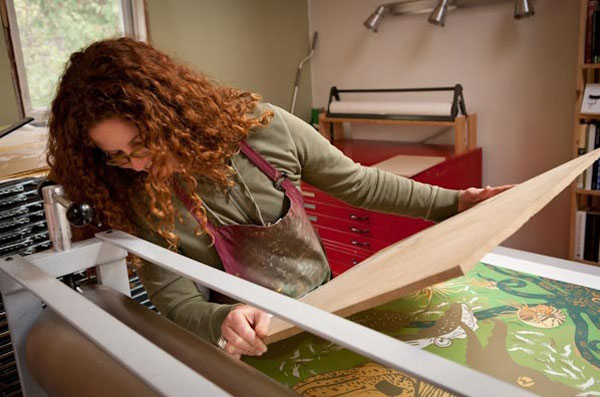
Q: Out of curiosity, where do you create your artwork? My guess would be outdoors or with easy access to it. Or, do you work from memory or sketches that you've done at an earlier time?
A: I make my artwork at home. I have a print studio inside and a building that I fondly call the "clay shack" outside. I do a lot of carving out there. In the summertime, I open the windows all the way up, turn the fan on, and open both doors. It's like being outside. A few days ago, I was carving and a baby deer ran by about 2 feet away from my legs. It was playing with its twin. I use photos for reference all the time and have a sketchbook that is full of writing as well as images that I look back on when I am thinking about my next piece.
Q: Your pieces often feature non-native species or plant-life. Does travel or exploration of other regions play a role in the research for your art?
A: People often ask me if I have been to the places that I make art about. I do love to travel and have been to a lot of places, the most exotic was Australia and I feel so lucky to have spent time in that country. I love islands and island life so I try to visit islands whenever possible. But, I have made art about many places I have never set foot in. I have a series about islands that I like to call, "Isolation produces oddballs," which features Myanmar and Indonesia, both places I have never been to.
Q: Is this your first year at Art Fair, and if not, what was your experience like last year? Why have you chosen to participate in Art Fair? Do you feel events like these are important for building a community around art?
A: I have been selling my art professionally at festivals for the past 8 years. The reason I do it is because I don't know a better way to make a living as an artist. I sell a lot of work online these days, but it is mostly to people who have seen it before at a show. I have a pretty hefty list of people who have signed my guestbook at festivals and I send out emails once a month when I finish a new piece. I think the festival environment is really helpful for artists being able to meet potential customers directly and build relationships with them. I think this will be my 4th year at Ann Arbor. My parents live about 40 minutes away so it is also kind of a family trip. I have friends from high school and college in the area so I love coming back. It's nice to see familiar faces. I always do at least one new show a year so often it is a sea of unfamiliar faces.
Q: How do you prepare for a big event like Art Fair? Are you featuring the work from your website mostly or will you be introducing a new series?
A: My woodcuts take a long time to make. I have been working on 2 pieces for 3 months and just finished one but am still working on the other. They all are editioned, but very limited. So, I will be showing the woodcuts that are on my website. All of my clay work is one of a kind. There may be some of the pieces from my website but I also have been stocking up and not posting my new work so that I have enough for the show. My frames are new this year. I have been displaying my pieces without glass. I have them professionally mounted and then they are varnished like an oil painting. I am working with a fabulous woodworker who is making beautiful hardwood frames (walnut and curly maple.) You won't be able to go to a frame shop and get anything like it so I hope to sell a bunch at the show.
Juliana Roth is a writer currently living in Ann Arbor whose poetry, essays, and fiction have appeared in The Establishment, Irish Pages, Bear River Review, DIN Magazine, and other publications.
Jenny Pope will be set up in the Ingalls Mall section in booth number A258 at this year's Ann Arbor Art Fair from Thursday, July 21 to Sunday, July 24, 2016. Jenny’s work can be viewed on her website or you can be follow her online on Instagram and Facebook.
Penny Seats Theatre presents Xanadu

Sometimes, you actively avoid re-visiting the most beloved TV shows and movies of your youth, because you know in your gut that the adult, more critical version of yourself will see nothing but flaws.
Yet when a witty playwright like Douglas Carter Beane (“The Little Dog Laughed,” “Lysistrata Jones,” “As Bees in Honey Drown”) adapts one of your favorite childhood movies – Xanadu, now being staged by Penny Seats Theatre – you get the best of both worlds. Yes, Beane affectionately mocks the campy film musical’s laughable absurdity, but he also unabashedly grants us permission to re-visit it, as well as its still-appealing ‘80s score (by Jeff Lynne and John Farrar).
For those of you who, for some reason, didn’t hold a cassette recorder up to the TV as Xanadu played on your family’s jerry-rigged cable system - ahem - here’s the story: frustrated Venice Beach artist Sonny Malone (Matt Pecek) is about to give up when Kira (Paige Martin) rolls into his life on a pair of skates. She’s a muse, one of 9 Greek sister goddesses who inspire artists, so she guides Sonny toward his dream: a roller disco that’s also an arts showplace. Naturally.
But when Sonny becomes business partners with a rich, older man (Roy Sexton) from Kira’s past, and Kira’s jealous sisters (Allison Simmons and Kasey Donnelly) decide to intervene to bring the upstart down, Sonny’s roller disco dream hangs in the balance.
Penny Seats’s outdoor production (in West Park) struggled mightily with sound issues on opening night. The actors’ mics were hit-and-miss, which meant that some lines (and jokes) got lost; ensemble numbers, particularly near the beginning, never quite gelled, vocally; and the show’s band – situated on the West Park band shell stage, a good distance behind where the action unfolds (which may have been one source of the problem) – often sounded pretty rough and out of sync, shifting tempos and struggling to align with the performers.
This is one reason why it’s particularly tough to stage a musical outdoors, of course. It’s harder for the performers and the musicians to hear and listen to each other, and focusing and balancing the sound is a challenge.
But that wasn’t the only difficulty facing Penny Seats in regard to this show. As the program notes, Xanadu's original director had to leave the production two weeks into rehearsal, so a number of local theater artists (R. MacKenzie Lewis, and Thalia Schramm and Matthew Brennan from Dexter’s Encore Theatre) pitched in to help direct the show, and an ensemble performer (Sebastian Gerstner) stepped in as choreographer.
Gerstner’s choreography is appropriately sassy and fun, and Ginny Reiche’s flowy costumes for the muses pop with color. Given the constraints of the open, outdoor performance space, some exits and entrances feel awkward; but using nothing more than a few free-standing columns, a phone booth facade, and a similarly-sized set piece with Sonny’s chalk drawing of the muses, cast members perform costume changes – and get into and out of roller skates – with impressive alacrity.
Martin looked a little shaky on her skates at times, but she generally has a ball playing golden-haired, favored-child Kira (known as Clio to her sisters and father Zeus), who glides dramatically across the stage each time she pronounces her own name, and adopts an Australian accent by way of a disguise – but mostly because Olivia Newton-John, the original movie’s star, had one. Martin’s well-cast with Pecek, who charmingly conveys Sonny’s dimwitted-but-sweet worldview while also providing solid vocals. Finally, Simmons’s quirky delivery gives her accomplice role added comic oomph, and Gerstner gets bonus points for flinging Martin over his shoulder on cue while donning a Pegasus head. (You heard me.)
Some of Xanadu's sound issues will likely get worked out as the run continues, but opening night felt like a show that wasn’t quite ready for public consumption yet – perhaps because of all the behind-the-scenes challenges previously mentioned.
But even while the production team progresses and makes fixes through the show’s run, there’s no denying the charming silliness of the material itself. The pop score still feels infectious, and the silly, warm-hearted goofiness of Beane’s book provides a temporary respite from the bad news pouring in from every part of the world just now. No, Xanadu won’t cure what ails us these days; but being able to giggle at a 1980s roller disco dream for 80 minutes is nonetheless a kind of comfort.
Jenn McKee is a former staff arts reporter for The Ann Arbor News, where she primarily covered theater and film events, and also wrote general features and occasional articles on books and music.
Xanadu has shows at 7 pm Thursday through Saturday now until July 30 at the West Park Bandshell. Tickets are available online.
Preview: Film and Performance: Brasslands and Rhyta Musik
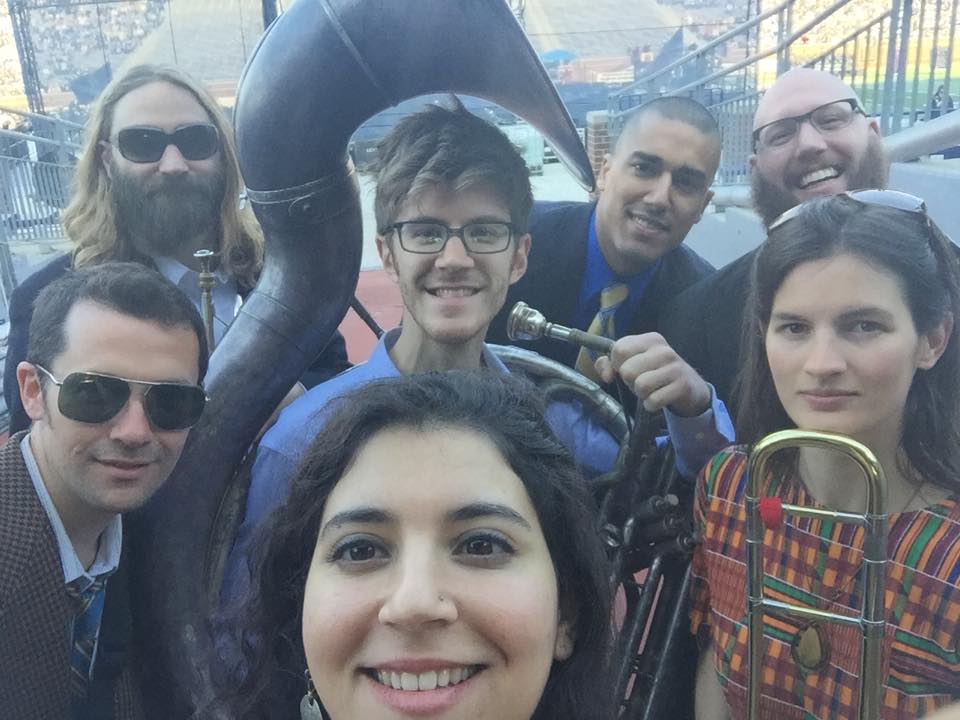
This Saturday afternoon, the Downtown Library's Multi-Purpose Room will be bursting with the exuberance and sounds of Balkan brass bands.
At 1 pm, Rhyta Musik kicks off the celebration — striking the tapan (bass drum) and snare —whipping up the energy with trumpet, trombone, saxophone, singing and lively dance. Their set navigates adeptly from originals to Eastern European folk melodies and back again.
If you enjoyed Rhyta Musik at Top of the Park or Water Hill Music Fest, you won't want to miss the chance to catch them again, and perhaps bring along a family member or friend. The band is plenty appropriate for even elementary-age kids as long as they are in the mood for something that's occasionally bombastic!
At 2 pm, following Rhyta Musik's performance, there will be a special screening of "Brasslands," an acclaimed 2013 documentary about the world's largest trumpet festival in Guča, Serbia.
Brasslands explores Balkan brass music through the tales of three individuals — a Roma street musician, a Serbian master of the trumpet, and a New Yorker who has been playing this music for three decades. The three stories all lead them to the 50th anniversary of the world's largest trumpet competition in a Serbian valley.
Brasslands lets viewers in on the hopes and fears of each of these musicians throughout their preparation and into the culminating event — playing in Guča's giant competition.
Mariah Cherem is a Production Librarian at the Ann Arbor District Library, and gets ridiculously happy hearing music in the library, from classic storytime songs on up.
The Rhyta Musik performance and Brasslands screening both take place in the Multi-Purpose Room of the Downtown Ann Arbor District Library on Saturday, June 16. Brasslands is now available to AADL cardholders for online streaming at aadl.org.
Review: Kate DiCamillo packs the Downtown Library on Sunday

Bestselling, award-winning children’s author Kate DiCamillo (Because of Winn-Dixie, Flora & Ulysses, The Tale of Despereaux) drew a few hundred excited fans – clutching books as if they were treasures – to the Ann Arbor District Library's Downtown Library on Sunday afternoon; and she not only read from her new novel Raymie Nightingale, but self-deprecatingly shared the reason for her “late start” as a writer.
“When I was in college, I had a professor who said to me, in my senior year, … ‘You have a certain facility with words. You should consider graduate school,’” said DiCamillo, dressed in sneakers, black jeans, and a black V-neck T-shirt, with a pink long sleeved shirt wrapped around her waist. “That’s exactly what he said, but I was 20 years old, and so, I heard something entirely different. I thought he was speaking to me in code, and that he was saying, ‘Wow. You are super-talented. I think that you’re probably the next Flannery O’Connor.’ So I thought, ‘Why should I bother with graduate school if I’m really talented? I’m just going to go be a writer.’ So what I did was, I used my mother’s JC Penney credit card and I got a black turtleneck, and then I was set to go. I just sat around, wearing the black turtleneck, looking bored and disdainful and having people go, ‘Oh, that’s Kate. She writes.’ I did that for 10 years. … You can dream all you want and have great story ideas in your head, but eventually, you’re going to have to sit down and figure out a way to do the work. And I didn’t figure that out until I was 30.”
DiCamillo’s now established her regimen, obviously, having published about 20 books over the course of 20 years. The author spoke about how a novel now generally takes a year and a half – working through 7-8 complete drafts – for her to write, and she advised aspiring writers to read as much as they can. But the suggestions didn’t end there.
“Another thing you have to do is find out a way to make a deal with yourself about how you’re going to do the work of writing. For me, it’s two pages a day. I’m not offering that as a directive, but saying that’s what I have found works for me. So I make myself write two pages a day, whether I feel like it or not. And guess what? I never feel like it. So what I do is, I do it first thing in the morning. I come downstairs, I pour the coffee, I go right in there and write the two pages before I can talk myself out of it. And I don’t know about you guys, but I’ve got a voice in my head that goes, ‘You don’t know what you’re doing. You can’t write a book. This is never going to work.’ I have found that that voice sleeps in ’til about 9 o’clock. So I get up at 5:30, 6 o’clock, … and when that voice shows up to say, ‘You fraud, you don’t know what you’re doing,’ I’ve already done the important work.”
With an easy, approachable charm, DiCamillo – her hair a gently messy, white-blond cloud – answered kids’ and adults’ questions for nearly an hour on Sunday, addressing her characters’ often-odd names (“The only explanation I have is, I am a strange person, and I grew up in the South”); how she doesn’t write from an outline (“It’s a terrifying way to write, but I find that if I know what’s going to happen, I have no interest in writing the story”); how she struggled to write following the huge success of her first novel, Because of Winn-Dixie (“I knew I was going to have to go in a completely different direction, and so, enter the mouse with extremely large ears [Despereaux”); why authors and illustrators usually have no communication with each other until after a book’s publication (“It was long my suspicion that authors are crazy, and artists are even crazier, so why should we have them talking to each other? I ran that by the publisher, and they said, ‘Yeah, that’s it’”); and how the experience of her father’s abandonment when she was 6 shaped her and made Raymie Nightingale – in which a girl enters a pageant in hopes that a win would convince her father to come home – one of her most personal books (“(Raymie’s) the kind of kid that I was: worried and hopeful and watching all the time and flexing my toes. … That’s as close as I’ve ever come to putting myself in a book”).
One of the scores of kids seated on the floor asked what drove DiCamillo to write stories.
“Part of it is being a reader and living for books,” DiCamillo said. “And you get told those stories, and you feel like you want to tell a story back. And part of it is, as hard as writing is for me, when I’m writing a story, I’m connecting to the world and to myself, and it helps me understand things. It makes the world make more sense if I’m writing.”
Indeed, one of the most sad and funny moments of DiCamillo’s talk arose when a fan asked where Flora & Ulysses’ surreal plot – focusing on a squirrel that’s sucked up into a vacuum cleaner and gains super powers and writes poetry – came from.
“My mother passed away in 2009,” DiCamillo said. “She had a tank Electrolux vacuum cleaner that she loved. And in the last year of her life, she said to me many times, ‘What’s going to happen to the vacuum cleaner after I’m gone?’ I kept on saying, ‘I’ll take the vacuum cleaner. Don’t worry about the vacuum cleaner.’ … She passed away, and I did what I promised. I took the vacuum cleaner, but I had to put it in my garage, though, because I’m allergic to cats, and my mother had the world’s most evil cat named Mildew. … So I put the vacuum cleaner in the garage, and every time I pulled into the garage, it would make me feel really sad, and make me miss my mother. So that’s one place where the story started. And the second thing that happened is, the spring after my mother died, a squirrel was on my front steps, draped in this very dramatic fashion and clearly unwell.”
DiCamillo called a close friend who said she’d come over and “whack him over the head.”
“I’m on the cell phone, right next to the squirrel, as she’s saying this, so I start to back away, because I don’t want him to hear it,” DiCamillo continued. “So I go in the side door, and I look out the front door, and guess what? He did hear it. He was gone. He clearly thought, ‘There’s better ways to die. I’m going elsewhere.’ So it made me feel sad, and it made me remember a wonderful essay that E. B. White wrote called ‘The Death of a Pig.’ … Before Charlotte’s Web came out, he was thinking about how to save a pig’s life, so I started thinking about how to save a squirrel’s life … And I combined the squirrel with the vacuum cleaner in the garage, and that’s where the story came from.”
Finally, an adult in the crowd asked about DiCamillo’s recent reference (in an interview) to a White quote that goes: “All that I hope to say in books, all that I ever hope to say, is that I love the world.” The fan asked DiCamillo to talk about the quote further in light of recent, tragic events.
“I think that we need stories more than we ever have needed stories, and we need to collect around stories and read stories out loud together,” said DiCamillo. “Stories teach empathy. You learn to think about what the other person is feeling, and it is so necessary to imagine yourself into somebody else’s shoes. And I think we need that so much right now.”
Jenn McKee is a former staff arts reporter for The Ann Arbor News, where she primarily covered theater and film events, and also wrote general features and occasional articles on books and music.
Review: Book + Paper Arts at WSG

Barbara Brown’s WSG Book + Paper Arts finds her latest book art exhibit—with a few paper arts thrown—nestled, as usual, at the intriguing intersection of ubiquity and uniqueness.
On one hand, like Brown’s prior WSG book-oriented displays starting with 2006’s Beyond Words, this edition of Book + Paper Arts calls into question the nature and function of “the book” while deconstructing by illustration what books look like.
What Brown’s exhibit ultimately shows us is that any commonplace assumption is at best questionable—and often simply irrelevant. As she says in her gallery statement, the emphasis of this occasional theme has evolved: “In previous show statements, I have put forth the assertion that the term ‘artist’s book’ often triggers much discussion, even bickering and irresolution amongst book artists, and the point has sometimes been made that at the very instant one uses that term, one must then be ready to define the definition!”
A commonplace definition would be that a “book” is a number of sheets of blank or ruled paper bound together for communicating expression. But this description is obviously a bit too loose to clarify what a book can be because the communication of expression can be as much abstractly symbolic as it is literature—hence, art.
So perhaps a more precise definition would be that a “book” is a handwritten or printed work of narrative fiction or nonfiction usually arranged on sheets of paper, parchment, or some other material fastened or bound together by surface covers. Yet this definition is obviously too tight—hence also, art.
It’s really this paradoxical slackness and restrictiveness that Book + Paper Arts seeks to imaginatively address. As Brown adds in her statement, “There will probably never be a determination that everyone agrees on, but I like ‘book inspired art’ (or BSO—book shaped object), and for me, that is a good beginning.”
“Book” art requires uniqueness, for even the most ardent conceptual use of the term denotes an object whose stance apart from the norm is the result of declaring itself aesthetic—with or without proper surface.
This makes WSG organizer Barbara Brown (as much ringleader here as she is curator) an artful instigator falling on the side of creativity as opposed to the omnipresent presence of the “book” itself. Working from the base definition (as indeed only a few of the artworks on display at the WSG actually even resemble books), Brown’s want (as well as the impulse of the artists in this exhibit) is to take this commonplace idea and twist, fold, manipulate, and mangle it until the concept virtually says (and ultimately is) what the artist wants it to say—or be.
This is indeed a sweet surrender. Because what the artists do in Book +Paper Arts is ultimately quite creative—certainly endlessly fascinating—even if the concept of book gets left behind in some equations. And so much better for what hangs and sits in the WSG Gallery.
Regional artists participating in the exhibit are Ruth Bardenstein, Ian McLellan Davis, Meghan Forbes, Alvey Jones, Norma Penchansky-Glasser, Ted Ramsay, Susan Skarsgard, Jack O. Summers, and Howard White. As local gallery browsers well know, this is an exceedingly distinguished (as well as insightful) clutch of talent. Calling out four artworks will reflect various stands—and strands—of these artists' intent.
For example, University of Michigan Art Professor Emeritus Ted Ramsay initially seems the furthest afield from book art in the exhibit—working in paper art rather than book art. In particular, his cast handmade rag paper, wood, enamel Memorial to Thylacines and Our Slaughtered Michigan Wolves seems definitely farthest afield—that is, farthest afield until the implication of his work is taken into account.
Linking the fate of this extinct South Pacific carnivorous marsupial to Michigan’s wolf population, Ramsey is stretching the use of paper art to bookend these creatures’ fortunes. Using his career-long strategy of creating vivid oversized three-dimensional tableau coupled with a whimsical canine reference, Ramsey’s work requires a bit of familiarity to plume his intent. Afterwards, and given the decided bent of his humor, Ramsay comes to book with a readymade arsenal of creativity that’s part aesthetic and part polemic. His Memorial to Thylacines and Our Slaughtered Michigan Wolves fits the bill.
General Motors Design Archive and Special Collections manager Susan Skarsgard has long made the alphabet her chosen topic and her contribution to this show devoted to book and paper art is a return of her iconic Alphabet Pop Up, a handsome wall-mounted copper metallic paper sculpture that we last saw in WSG’s Beyond Words 2008 edition as well as 2009 in Washtenaw Community College’s At the Junction: Calligraphic Design exhibit. It’s good to see this masterwork again.
A tidy three inches wide by six foot in height, Alphabet Pop Up’s near-abstract rendering of the ABCs is both compact and nifty. Keying on the common Latin grapheme and rendering each letter in a handsome blockish type, while also paying attention to descending scale, Skarsgard’s Alphabet Pop Up is a welcome reminder that sculpture, too, can be conceptually dependable as well as commendable—you can, as it were, make book on it.
![Mapaloopsa by Jack O. Summers [mixed-media].](/files/images/pulp/map_assemblages_jack_summers-2016.png)
Detroiter Jack O. Summer’s Mapaloosa is an imaginative reordering of the world’s geography through a series of colorful plates. As he says of this book art, “This clam shell of mixed up countries was created to illustrate how our world is changing and how we are impacting each other and losing some of identity as our planet becomes more crowded and disturbed.”
Fair enough. But the irony of Summer’s aesthetic is that even as these juxtapositions of differing architectural, national, and geographic boundaries are visually jarring slivers and chunks of familiar locales willy-nilly thrust upon each other, his mash-up of geopolitical boundaries and geographic landscapes in Mapaloosa also have an artful logic that meshes the unusual arrangements together.

Finally, it would be unfair to conclude without a tip of the artistic hat to Brown and her video collaborator Howard White. Their 15”x15”x20” Midsummer theater book certainly fits the definition of book art if anything does. It’s a miniature rectangular bookish movie theater with short feature film squeezed together as one—and an intriguing nature-based documentary, at that.
What Midsummer best illustrates is Brown’s unyielding commitment to book art—however it’s defined—through her reworking this object in multiple medias to expand and enlarge the definition until the concept encompasses the entire range of neo-Dada assemblage.
And that’s ultimately a hefty handful of art.
John Carlos Cantú has written extensively on our community's visual arts in a number of different periodicals.
Book + Paper Arts will run through July 30, 2016. The WSG Gallery is located at 306 S. Main Street: Tuesday-Wednesday, noon–6 p.m.; Thursday, noon-9 p.m.; Friday-Saturday, noon-10 p.m.; and Sunday, 1–5 p.m. For information, call 734-761-2287.
Preview: DJs in the Garden at Mini-Moogfest

A good two-thirds of the time that I mention the garden at the downtown location of the AADL to friends, I get a “What? There’s a garden?! Where?" in response.
It can feel like a secret, even though it’s open to everyone. Tomorrow, that very garden so many people have yet to discover will be filled with music by some startlingly talented folks as AADL kicks off its second official Mini-Moogfest.
If you were lucky enough to swing through last year’s inaugural festival, you know that it was not only a chance to listen to some great DJs, but also an opportunity to play around with the breadth of music tools available for checkout at the library.
The ability for all ages to play with all sorts of goodies — from kid-friendly simple instruments to synths to effects pedals to beat-making little boxes — remains a key part of this year’s festivities, and talented, world-class DJs return to play music in the library’s garden.
Catch Mike Dykehouse 12-1:30 pm, Tadd Mullinix (fresh off a performance in Detroit the night before) 1:30-3:00 pm, and Mike Huckaby 3-4:30 pm.
Mariah Cherem is a Production Librarian at the Ann Arbor District Library, and gets ridiculously happy hearing music in the library, from classic storytime songs on up.
Mini-Moog Fest takes place in the garden area of the downtown location of the Ann Arbor District Library on Saturday, June 9 from 11am-5pm. In the case of rain, the event will be held inside.
Review: Bruce Hornsby & the Noisemakers at the A2SF

Those of you who have followed Bruce Hornsby since the 80s and were prepared for something looser, more genre-bending: you weren’t disappointed. Those of you who remember Bruce from his 80s music and not much else: I hope you were ready for something other than studio album re-creations.
Bruce Hornsby and the Noisemakers made beautiful noise for two hours on Thursday evening at the Power Center to an appreciative audience that filled about three quarters of the Power’s seats. The Noisemaker’s singular talent -- aside from stunning musicianship -- is to make old new again, and to the audience’s delight, that’s exactly what happened. They also happen to be really good at making entirely new music, and we heard some of that as well. All this, despite a less-than-excellent sound mix and several technical issues that had Mr. Hornsby gritting his teeth.
The Noisemakers are bassist J.V. Collier, a twenty-year veteran of the band, as well as keyboardist/organist John “JT” Thomas and drummer Sonny Emory, who have played with Hornsby twenty-four and twelve years respectively. Summer 2014 marks the arrival of two new Noisemakers — fiddle/mandolin player Ross Holmes and guitarist Gibb Droll — as well as the departures of longtime members Bobby Read and Doug Derryberry. Holmes currently fiddles for Mumford and Sons, has played with hosts of Nashville titans as diverse as Ricky Skaggs and the Dixie Chicks. Droll has played guitar on various projects involving Keller Williams, Kevin Kinney, and Brandi Carlile.
Picking and choosing from their just-released album Rehab Reunion, as well as other Hornsby discography highlights like "The Way It Is," BH&N demonstrated their individual musical prowess through improvisational solos that spanned and twisted jazz, pop, bluegrass, and Americana genres in a way you will never hear in any other band.
More evidence of Bruce’s live concert experience and expertise: the mid-set featuring acoustic duos and trios out front served to mix up the sound, feel, and intimacy of the event. The band’s working motto: “Look at Bruce!” Whatever the song, every band members’ eyes were locked on Bruce as he would often point to a soloist without warning for an impromptu 12 or 24 bars. The band is tight and loose at the same time, knowing their stuff but subject to Hornsby’s split-second diversions.
Above it all, Bruce’s piano skills wowed the crowd as he created improvisational dances on the keyboard. Bruce Hornsby is not a technical perfectionist on the Steinway, but the musical emotion he generates through his from-the-heart meanderings give new life to his classics. The audience would hold our heads to prevent musical whiplash as he’d take an iconic song like "Valley Road" in a unique and re-syncopated direction with dulcimer (Hornsby), mandolin (Holmes) and shoulder-mounted washboard and spoons (Emory).
The evening’s best moment: a wandering, jazz-infused take-off on the 1989 collaboration between Hornsby and Don Henley, "The End of the Innocence." I would need to have recorded the live track to tell you how many improvisational turns this song took as it raced through styles and genres. I can only tell you that Bruce’s emotional keyboard interlude had the crowd ooh-ing, ahhh-ing and hooting approval.
A brief encore followed the satisfying performance with a surprise appearance from Jeff Daniels, who complained, “you guys play all this stuff in E-flat diminished 9th chords” and finished the night with Bruce and band in a rousing 3-chords-and-the-truth rendition of his "Go Henry David Go."
Bruce is my age, and I have grown up with him as he has blessed my life with some of the best music I can remember. Thursday night did nothing but drive my appreciation for him that much deeper. Don’t stop for a while, Bruce. Keep improvising. You’re not finished.
Don Alles is a marketing consultant, journalist, house concert host and musical wannabee, living in and loving his adopted home, Ann Arbor.
Preview: The Suffers Play Sonic Lunch
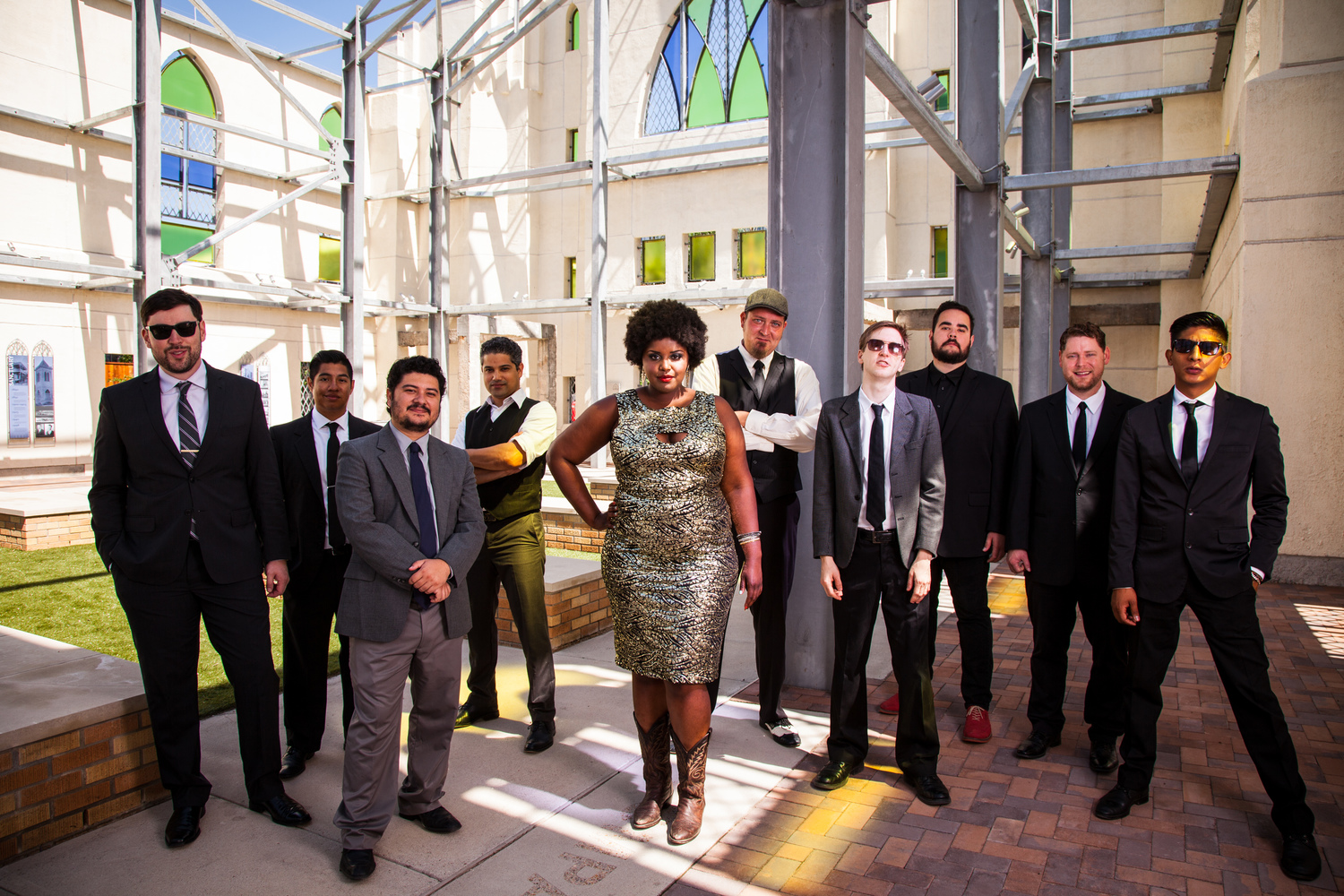
Self-coined “gulf coast soul” band The Suffers are gracing Ann Arbor with their presence to play Sonic Lunch on Thursday, July 14 and boy oh boy, the city is in for a real treat. The band brings a fresh and unique approach to soul music, bringing rock and roll, hip hop and Latin tinges to a Motown-like base. The Suffers first visited Ann Arbor in 2015 when they played at The Ark after releasing their EP Make Some Room. Having attended the show, I can attest to the fact that people were truly dancing in the aisles for much of it and I expect nothing less of their performance at Sonic Lunch. Most recently, The Suffers were touring with Lake Street Dive, a near-perfect partnership that stopped by Royal Oak in March.
Hailing from Texas, the 10-member ensemble band is fronted by singer Kam Franklin and her extraordinarily powerful voice. Often clad in something shimmery or coated in glitter, it’s impossible for Franklin not to command the stage as she strides back and forth belting out tunes, flanked by her all-male bandmates who are equally energetic. Particularly fun to watch are the horns—Mike Razo on the trombone, Cory Wilson on the saxophone and John Durbin on the trumpet—who have managed to get most of their movements in sync along with their playing. Nick Zamora and Jose Luna comprise the percussion section of the band, while Adam Castenada plays bass and Kevin Bernier and Alex Zamora play guitar. Pat Kelly rounds out the crew on keyboard.
Needless to say, one of the most interesting early moments of The Suffers’ Sonic Lunch performance will be seeing how they manage to fit the entire band on the stage. What’s most touching about The Suffers is their down-to-earth attitude despite their ability to completely wow crowds with their command of the music they play. You get the impression that when they’re done performing they’re just going to go back to whatever hotel they’re staying in, have a beer and hang out with each other. Franklin typically chats with the crowd between songs asking quirky questions and talking about the band’s life in Texas and what they all did before coming together to play as The Suffers. These casual conversations and overall relaxed attitude of the band make it even more shocking when they launch right back into another hugely powerful song.
Along with being nearly constantly on tour this past year, The Suffers made time to perform an NPR Tiny Desk Concert, play The Late Show With David Letterman, and release their debut self-titled album on CD and vinyl.
Sonic Lunch on the 14th is certainly one of the only chances any of us will have to see the band for free, and although they’ve favored Michigan in the past with their tour dates, who knows when they’ll be back? This is definitely a show not to be missed.
Elizabeth Pearce is a Library Technician at the Ann Arbor District Library. She also likes to dress in things that are shimmery and coated in glitter.
The Suffers are playing Sonic Lunch in Liberty Square on Thursday, July 14 at 12:00. The concert is free and open to the public.
Fabulous Fiction Firsts #604

"It washed over me for the first time in my life how much importance the world had ascribed to skin pigment..." -Sue Monk Kidd
With references to William Faulkner's Absalom, Absalom! (1936), Suzanne Feldman's debut (and a winner of the Missouri Review Editors' Prize) Absalom's Daughters* is a tale of sisterly adventure through the 1950s Jim Crow South.
Young Cassie helps run the family laundry with her mother and grandmother in the black part of Heron-Neck, Mississippi. She has no idea that Judith who is white, is her half-sister, though she knows that it is her grandmother's plan to orchestrate the births in her family so that her descendants can, one day, pass for white.
When their father Bill Forrest runs off leaving the family destitute, Judith finds a letter from a mysterious sender in Virginia explaining they are heirs to a rumored family fortune, surely enough money for her to run off to New York City to be a singer. Sensing that her grandmother's design on the jazz-playing Albino boy from New York City visiting one of the white families on the hill, Cassie realizes this may be her only opportunity to escape. The girls steal a car, and with a ham, a gun, and a map so old that state lines are blurred, they head north. While getting their first taste of freedom, courting danger at every turn, they are also reminded of the tyranny of skin color, and the heavy responsibility of being the master of your own fate.
"Feldman’s prose blisters and pops with sparks...In this novel, most things are not as they seem, and Feldman doesn’t hew too close to reality. The sisters encounter mules who were once men, discover towns that appear in one place on the map and another on the road, and Cassie even spends a few days as a white girl. Eventually she decides to return to the skin she was born with; as a mysterious woman tells her near the end: 'What’s important is the past.'" (Kirkus Reviews)
* = starred review
Arts Writers! UMS Seeking Candidates for a New Fellowship

The University Musical Society (UMS) is seeking applicants for their Wallace Blogging Fellowships. This recently-announced opportunity aims to promote cultural events taking place throughout southeast Michigan, and includes a stipend and special access to UMS events and guests.
So, know anyone in the area who is over 21 and loves the arts? Send the application their way! The deadline to apply is July 15, so get those writing samples ready!

